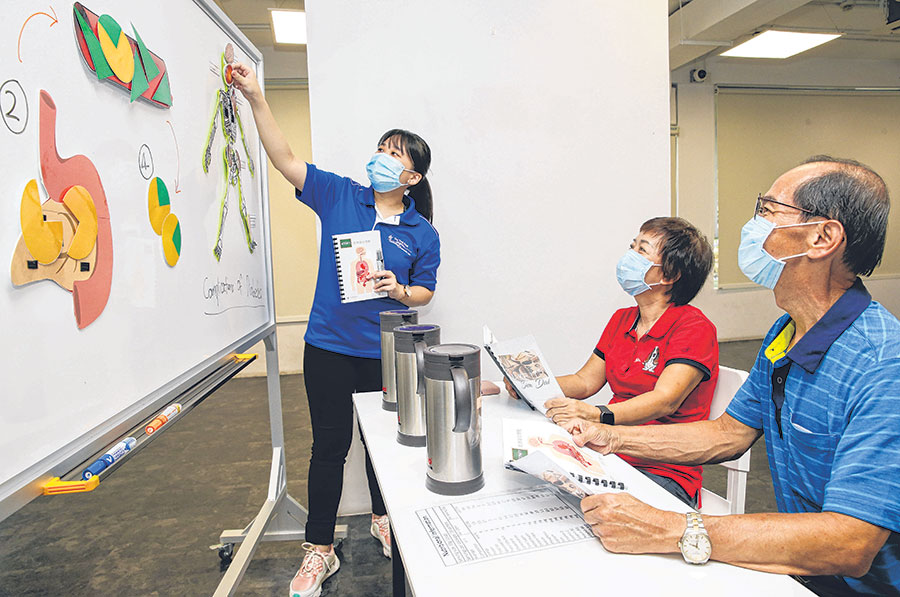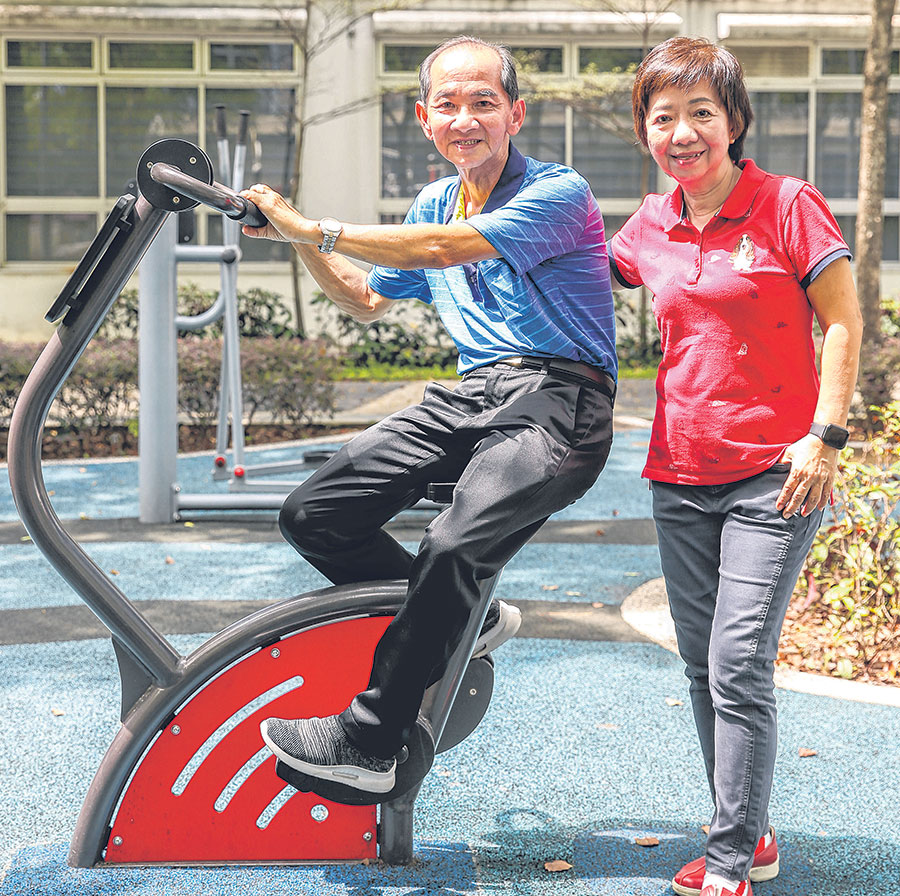 Tan Tock Seng Hospital health coach Cheong Pei Fen teaching retirees Jennifer Tan and her husband K.S. Chua about diabetes under a community wellness programme called Make It Siew Dai. ST PHOTOS: YONG LI XUAN
Tan Tock Seng Hospital health coach Cheong Pei Fen teaching retirees Jennifer Tan and her husband K.S. Chua about diabetes under a community wellness programme called Make It Siew Dai. ST PHOTOS: YONG LI XUAN
The Straits Times (7 April 2021)
Tan Tock Seng Hospital coaches inculcate healthier habits, diabetes prevention and more in wellness programmes
From having at least three cups of extra sweet tea to just a small cup of tea with less sugar daily, retired taxi driver K.S. Chua changed his diet after a health scare two years ago.
He was found to have prediabetes then, where the blood sugar level is higher than normal.
At the urging of his wife Jennifer Tan, 64, he joined her in a community wellness programme called Make It Siew Dai ("less sweet" in Chinese dialect), aimed at residents at risk of diabetes. He was reluctant at first.
"In the past, I ate everything. I ate very unhealthy food like char kway teow and orh lua (oyster omelette) at least two times a week," says Mr Chua, 68.
Make It Siew Dai is one of the programmes run by health coaches from Tan Tock Seng Hospital (TTSH). These cater largely to residents of central housing estates such as Toa Payoh or Serangoon, although residents of other estates can sign up too. The programmes are free and targeted at seniors.
Under the programmes, residents can get health advice through oneon-one consultations, take part in activities like exercise sessions or go for classes to learn about healthier food options, among other topics.
The number of residents taking part in these programmes has jumped from 68 in 2016 to 6,180 last year.
Health coach Cheong Pei Fen, 24, who has a diploma in health management and promotion, says participants are also encouraged to set goals to adopt a healthy lifestyle.
Madam Tan got her husband to take part in the programme conducted at Jia Ying Senior Activity Centre in Hougang, which comprised eight three-hour sessions. "He was so lethargic at the start, but his health improved slowly, lesson by lesson. It is better than my nagging, which doesn’t work," says Madam Tan.
Both of them have since made changes to their lifestyle. "We learnt how to portion our food and opt for whole-grain food instead. In the past, my husband hardly exercised. Now, he exercises almost every day for an hour," she adds.
Ms Cheong says the participants were generally receptive to the advice, but one challenge many faced was finding the time to exercise.
Under one of the programmes conducted by TTSH, called Walking Foodpedia, residents are taught about healthier food options. They learn to read food labels in a mock-up minimart and whip up healthier meals using nutritious ingredients.
Health coach Audra Suratman, 26, who conducts the programme, tries to debunk misconceptions participants have about certain foods.
Some get confused about what they should or should not eat after hearing advice from friends or online sources, says Ms Audra, who is also a nutritionist.
"We always remind residents to check if their friend has certain conditions that cause him or her to avoid certain foods and check if the online information comes from a reliable source."
Besides getting health tips, residents have also made friends through the programmes.
Some, like Madam Sally Soh, 60, even became peer support leaders to encourage fellow participants to keep up their good eating habits after the four-session programme.
Madam Soh, a retiree who lives in Ang Mo Kio, organises cooking sessions with her peers, where she prepares healthier dishes such as flour vermicelli steamed cake.
She attends such wellness programmes to get pointers on how to maintain a healthy lifestyle and shares these tips with her peers.
"We must keep learning how to live healthily," says the grandmother of five. "After all, our health is in our hands."
 Madam Tan and Mr Chua learnt to portion food and now opt for whole-grain dishes. They also exercise almost every day for an hour.
Madam Tan and Mr Chua learnt to portion food and now opt for whole-grain dishes. They also exercise almost every day for an hour.
Tips on healthy living
-
REDUCE SATURATED AND TRANS FAT INTAKE: Opt for lean meat or remove visible fat and skin. Adopt healthier cooking methods such as steaming, baking and grilling. The intake of saturated and trans fat raises the risk of fat deposits in the blood vessels. Excessive fat intake can lead to weight gain and increase the risk of developing diabetes.
-
INCREASE YOUR FIBRE INTAKE: Eat two servings of fruit and two servings of vegetables daily. Incorporate whole grains such as brown rice, chapatti, oats and wholemeal bread into your diet. Fibre helps to slow down the absorption of glucose into the bloodstream and keeps you full for a longer time. It also helps to promote healthier bowel management and aids in weight management.
-
REDUCE INTAKE OF REFINED SUGARS: Limit consumption of sweetened beverages, fruit juice, cakes, kueh, desserts, ice cream, chocolates and sweets. Go for water or sugar-free beverages as much as possible. Refined sugars are quickly absorbed by the body and can cause the blood glucose level to rise quickly.
-
LOWER INTAKE OF SODIUM: When eating out, ask for gravy on the side instead of drizzling it over your food to control the portion. Consuming too much sodium can increase the risk of hypertension, which can lead to health complications such as stroke, heart attacks and kidney failure.
-
GET MOVING: Exercise for at least 30 minutes a day, five days a week. Get off the bus or train one stop earlier and walk the rest of the way or choose the stairs instead of the lift.